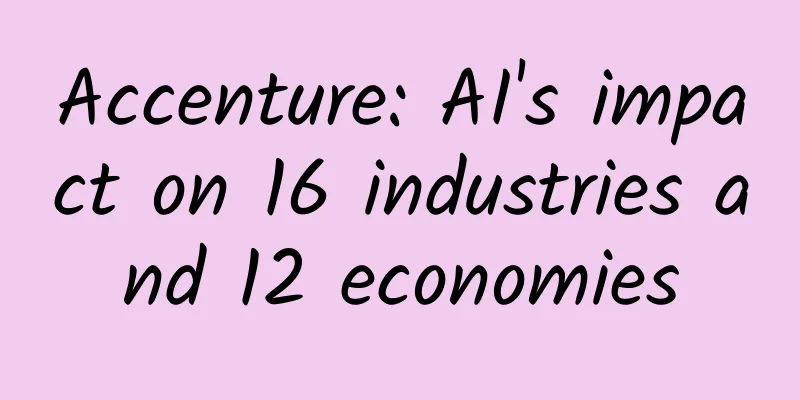Accenture: AI's impact on 16 industries and 12 economies

|
Why do we say that? Although the outlook looks bleak, hope is at hand. The new factor of production, artificial intelligence, can not only bring economic growth, but also improve corporate profitability. Accenture defines artificial intelligence as a collection of technologies that enable intelligent machines to expand human capabilities through perception, understanding, action and learning, thereby greatly improving human output. The massive amount of data, the increasing speed of computer calculations, the continuous reduction in costs and breakthroughs in technical difficulties have made the business prospects of artificial intelligence increasingly clear. In Accenture's view, artificial intelligence technology is not only a catalyst for productivity, but also a factor of production in itself, which can enable companies to turn losses into profits in the following three ways: optimizing business processes with the help of automated systems, increasing human efficiency and capital investment, and promoting innovation. However, in order to stand at the forefront of this trend, all industries must incorporate artificial intelligence into their development strategies and develop artificial intelligence systems that follow the ethics of human society and seek welfare for all mankind. Artificial intelligence can improve the scale and efficiency of artificial intelligence, and it can continue to evolve over time. It is precisely because of these characteristics that artificial intelligence has become a mixture of capital and labor, which also puts forward new requirements for investment models, innovation models and human capital development models. Economic impact of AI on countries: Our model shows that in all 12 countries we analyzed, AI has the potential to double the annual growth rate of gross value added (gross value added is often used to estimate a country’s GDP) by 2035. The economic potential of artificial intelligence In the information and communications industry, which relies heavily on technology, the integration of AI capabilities with existing systems could generate a total value of $4.7 trillion by 2035. For example, suppliers could develop new AI platforms to provide customers with cyberattack protection services. In manufacturing, pioneers like the Internet of Things (IoT) are creating favorable conditions for the seamless integration of intelligent systems. Today's IoT technology enables physical equipment such as assembly lines to connect and communicate with digital systems. In addition, artificial intelligence can also narrow the gap between current automation and learning forms through more advanced forms. Our research shows that AI could add $3.8 trillion to GVA by 2035, a nearly 45% increase over the business-as-usual scenario. Financial services could use technology to relieve knowledge workers from routine, repetitive tasks such as customer inquiries, mortgage underwriting, and market research. Overall, the industry could benefit from $1.2 trillion in additional gross value added (GVA) by 2035. Even labor-intensive industries, where productivity growth has been unusually slow, could see a sharp rise in GVA. By 2035, educational attainment would rise from 0.9% to 1.6%, and social welfare services would increase from 1.6% to 2.8%, significantly increasing economic output (total added value would increase by $109 billion and $216 billion in the two scenarios, respectively). By 2035, AI has the potential to increase economic growth by 1.7 percentage points in 16 industries. Real gross value added (GVA) 2015 (trillion USD) Artificial intelligence can boost industry profits Intelligent Automation: AI has huge advantages over traditional automation. For example, in the supply chain management industry, where time is money, a supply chain that is shortened by one day can free up $50 million to $100 million in cash flow for an average Fortune 100 company. Companies like Tesla and Johnson & Johnson, which rely on global integrated networks, are putting their supply chain management on Elementum, an AI startup supply chain management platform, to streamline their supply chains. The company provides real-time supply chain visibility by monitoring and analyzing one-time events, tracking transportation, and recording manufacturing output. By analyzing more than 10 million events per day and products worth $25 trillion in real time, Elementum can warn of potential problems at an early stage and propose alternative solutions. For example, in 2014, a fire broke out at a system memory card factory in China, which put considerable pressure on global supply at the time, compressing it by about 25%. However, most manufacturers only realized this after a few days, but Elementum's customers had a clear understanding of the incident within minutes and ensured their own memory card supply security before prices responded to the shortage of goods. Not only the production chain can benefit from intelligent automation, sales activities also require valuable time and resources to track potential customers. With the advent of artificial intelligence, sales activities have undergone tremendous changes. LE (Lattice Engines) focuses on using artificial intelligence to make the sales process more rational. By learning the company's purchasing patterns, it can sort potential customers from top to bottom according to popularity. Dell's European marketing department uses Lattice's artificial intelligence platform to reduce sales targets by 50%, thereby doubling sales efficiency, effectiveness and financial revenue. Labor and capital expansion: AI can improve workers’ productivity by transferring low-value-added tasks to machines, allowing employees to focus more on their primary tasks. The application of AI is expanding into areas where knowledge and critical thinking have long dominated, such as business research, which has traditionally been a very time-consuming task. Conatix’s semi-automated business intelligence system has recently improved its machine learning capabilities, enabling client companies to discover, coordinate, structure and share unstructured data and information that was previously outside their organizational structure. By working closely with researchers, Conatix algorithms can adjust their courses based on human feedback to provide high-quality information. AI can also help companies maximize asset utilization. Heavy industries, such as energy and manufacturing, require large upfront investments, which make them particularly vulnerable to lost revenue from downtime. Take wind turbines, for example: Unexpected downtime requires coordinating equipment, maintenance personnel, and spare parts, which ultimately results in financial losses. Another example is the case of gearbox failure. If each failure can lead to up to two weeks of downtime, then increasing asset utilization will undoubtedly shorten downtime and reduce losses. The benefits are obvious. NEM, an artificial intelligence startup, uses an algorithm based on the human immune system to improve the production efficiency of wind power plants, mainly to predict and prevent power failures. The platform first analyzes the failure of wind turbines to understand their symptoms, and then monitors the turbines in real time to see if there are similar symptoms and find potential problems. “As a new factor of production, AI can drive economic growth in at least three important ways,” said Mark Purdy, managing director of Accenture Research. “First, it can create a new virtual workforce, which we call intelligent automation. Second, AI can supplement and enhance skills, making more efficient use of existing labor and physical capital. Third, like other technologies before it, AI can drive economic innovation. AI will slowly become a catalyst for large-scale structural changes in society over time, because the use of AI will not only make things different, but also do something different.” Innovation Expansion: Artificial intelligence is poised to drive innovation by accelerating the development of new products. This innovation eliminates excess costs, generates new sources of revenue, and thus increases a company’s profitability. The development of new drugs can serve as a typical case. Currently, drug development is mainly based on discovery methods guided by theoretical hypotheses, yet less than 10% of new drugs are ultimately approved. BergHealth uses artificial intelligence to track the course of cancer, with trillions of data points on both cancer cells and non-cancerous cells. The company has produced a new anti-cancer drug using this method, which is currently undergoing clinical trials. It is estimated that this new drug development approach will reduce the cost of developing a drug from $2.6 billion to $1.3 billion. Artificial intelligence can also make new products with design goals and constraints. Autodesk has pioneered this new approach with its computer-aided design system "Dream Catcher". "Dream Catcher" uses artificial intelligence algorithms to create thousands of virtual prototypes from the cloud, and compares their functions, costs, and materials with specific standards, and then produces a model entity that meets the ideal, and finally sculpts the material. It will save memories of materials that deteriorate or improve performance, allowing the algorithm to understand how much each piece of material contributes to the whole. In the healthcare industry, "Dream Catcher" is used to design a facial implant that can accelerate recovery and tissue regeneration. Industrial profit potential Impact of AI on industry profits, increase in profit share for each industry between the 2035 baseline and the AI steady state In addition, the manufacturing industry was the first to use artificial intelligence technology due to its heavy reliance on heavy machinery. Our research suggests that the manufacturing sector could generate $3.8 trillion in additional revenue from AI by 2035. Channel expansion is expected to account for the bulk of the benefits to this sector, not only by making human labor more productive but also by enabling existing machines on factory floors to realize their full potential. Healthcare: In the model, AI will increase the growth rate of the healthcare industry from 2.2% to 3.4% in 2035, which will add an additional $461 billion in GVA. The intelligent automation channel accounts for more than 60% of this, with AI systems analyzing large amounts of unstructured data and producing predictive diagnostics to detect problems before they become serious health risks. The innovation channel will add more than $100 billion to the industry by 2035. One example of the huge potential of AI in healthcare is the industry's collaboration with related fields, such as manufacturing and design, to create cutting-edge 3D printing technology for organ transplants. Business leaders have an opportunity to adopt the following eight strategies. 1. AI strategy and leadership: In too many companies and industries, the impetus and interest in AI still comes from the middle and lower levels of the company, from digital enthusiasts who are exposed to technology and want AI to develop and are very excited about it. However, our analysts suggest that to get real value from AI, recognition and active action from the top of the company are needed, and the first crucial step is to make the benefits of AI visible to the top of the company. This means spending time with real AI machines, interacting with them, interrogating them, and testing them. There is no substitute for visiting an AI lab or innovation center where experts explore, test ideas, and develop prototypes. A roadmap for AI development will be essential in the future development of a company. Incorporating AI as a key enabler should be part of a company's plan to grow its business. Therefore, business leaders and strategic planners need to fully master AI to effectively change existing business plans, define key decision points, and guide correct investment decisions. 2. Transform HR into HAIR (AI Human Resources): Since AI is a virtual laborer, it will interact with the workforce, contribute and add value, just like human colleagues. The role of the Chief Human Resources Officer will not only manage employees, but also manage AI employees - this is HAIR (AI Human Resources). This will raise questions such as: How can companies restructure performance appraisal standards? How can the relationship between artificial intelligence and human labor be optimized? The conclusion is: Chief Human Resources Officers will play a greater role in business strategy and innovation, and have a greater technical understanding of artificial intelligence technologies and how they will affect future work. The HR department function itself will also need to incorporate artificial intelligence technologies into all aspects of its work, from recruitment to retirement. For example, SAP's Success Factors helps companies transform human resource management from "siloed self-service to intelligent services." The application, used by Microsoft, synchronizes standard procedures, provides an employee collaboration platform, draws actionable insights from work data, and predicts the impact of resource decisions on other business areas. 3. Learning with machines: To realize the full potential of artificial intelligence, human and machine intelligence must be closely integrated. In the workforce, it is necessary to develop new skills to leapfrog existing technical expertise and re-emphasize human abilities—judgment, communication, creative thinking—to complement mechanical skills. Artificial intelligence will not only change what people learn, but also how they learn. Traditionally, career paths have followed a linear process from entry-level to experienced. However, as artificial intelligence will replace humans to complete ordinary and low-value-added work, a skills gap will emerge between young professionals and older employees, and employees with work experience will be more adept. In order for companies to adapt to the changing natural learning process and employee training process, business leaders can focus on the needs of their employees, especially in the development of flexible skills. For example, Mastercard is trialing an AI software that uses the knowledge of experienced employees to help their staff become better sellers. Combining insights from humans and big data, the software can extend the expertise of experienced people to the entire team, reducing the need for large training teams. The centralized knowledge and experience input AI can serve as a personalized advisor to each member of the sales team in order to optimize their sales strategies. 4. Appoint a Chief Data Supply Chain Officer: The performance of AI will directly depend on the quality and quantity of available data. Accenture research shows that most executives are unsure of the business results they get from data analysis projects, which may mean that corporate data is still not fully utilized. Although many large companies have added Chief Data Officers (CDOs) to the executive level (Gartner estimates that by 2019, 90% of large companies will have a CDO), a key focus of these executives is data security, supervision and governance, rather than managing data and letting data form the evolutionary supply chain of AI. The Chief Data Supply Chain Officer will need to build a complete, end-to-end data supply chain, considering: What is the balance between internal and external data sources? How much data does the company have every day? Where is the data stored? How can our company simplify data access? Questions like these. 5. Create an open AI culture: Corporate culture must adapt to the image of its new AI workforce, where humans and machines will collaborate, teach each other, and learn from each other. This requires trust, openness, and transparency, just like any partnership. For example, people may initially blame the machine for poor performance or wrong outputs, rather than defining where the flaws are - whether human or machine - and improving them. Just like discordant interpersonal relationships and hostile transactional interactions, this will become an obstacle to jointly overcoming difficulties and maximizing shared value, rather than ultimately helping the computer to help itself. AI’s impact on job security, wages, and privacy will also affect employees’ attitudes and how they embrace AI behaviors at work. Leaders have a responsibility to explain the risks and opportunities that come with a hybrid workforce. But they can also shape culture and guidelines to minimize risks and maximize opportunities. Companies can go a step further by proactively using AI itself to improve workplace culture. AI solutions already exist. For example, it can detect emotional stress and employee burnout through natural language processing, helping managers shape and improve workplace culture and satisfaction. 6. Go beyond automation: In the past, automation has been key to business strategy, however, with the advancement of artificial intelligence technology, companies need to go beyond their own capabilities to harness intelligently powered, self-learning and self-managing machines. Accenture research shows that the potential benefits of AI are far greater than the impact of automation in the past, for example, between 1993 and 2007, traditional automation systems are estimated to have generated 0.9% additional annual growth, compared to 0.9% in developed economies. However, in Finland, the future impact of AI could be 70% higher than traditional automation, compared to 50% in the United States. Therefore, embracing AI can establish a strong competitive advantage for companies. For example, Bosch is putting AI at the forefront of their business. The company's "Thinking Factory", currently being rolled out in Bosch's German car factories, aims to enable AI machines to self-diagnose technical faults, automatically order replacement parts, and predict maintenance needs. Overall, Bosch predicts that widespread use of smart systems and machines will generate more than $2 billion in additional revenue and savings by 2020. 7. Bringing the masses into cloud technology: Over the past decade, companies have used the power of the masses to develop innovative models. At the same time, cloud technology provides an opportunity to quickly reduce computing costs and is not restricted by internal IT structures. The next step in innovation will be to combine crowdsourced data in the cloud with the power of AI to create new and disruptive business opportunities. To this end, cloud platforms such as Google Cloud Platform and Amazon Web Services have already begun to use it. 8. Use algorithms to measure your returns: Traditional factors for measuring production factors include return on capital (ROC) and employee performance indicators. As a new production factor, artificial intelligence will take new or adaptive measures. Unlike the depreciation of traditional assets, artificial intelligence assets can continue to gain value over time because of their self-learning technology. This compound asset appreciation effect creates higher returns for companies that invest in early artificial intelligence. Moreover, while some of its applications have clear outcomes, the learning nature of AI means that many benefits are not yet definitive. Therefore, in the AI era, traditional measures for tracking capital investments will become obsolete, and CFOs will need a new toolbox to measure the “return on AI.” Perhaps it will be related to the value generated by each algorithm, or a calculation of initial expenditures and ongoing costs, with most of the benefits and costs coming in future periods. Investors will assess future value based on their confidence in it. This complexity may deter human investors, highlighting the urgent need for new thinking and new terminology on capital expenditures and valuation models. Perhaps AI itself will be used to calculate more accurate predictions about AI. “To seize the AI opportunity, companies must act now by developing a strategy around AI that puts people at the center and commits to developing responsible AI systems that align with moral and ethical values, drive positive outcomes and free up humans to do what they do best – imagine, create and innovate,” said Paul Daugherty, chief technology and innovation officer at Accenture. Modeling the GVA impact of AI 1. We draw our results from a study that investigated the proportion of tasks affected by AI in the entire labor market. We estimate how likely individual occupations are to become automated in the future. We then look at the distribution of these occupations at the industry and country levels using labor statistics from the target countries. This practice of matching the degree of impact of AI with the occupational distribution in each country and industry allows us to determine the AI absorption rate in each country and industry. 2. We include quality improvements in AI over time, which we measure by referring to data on software, hardware, robotics, and cloud computing prices from 1990 to today. 3. We determine the additional innovation effect expected from the diffusion of AI in the measure of total factor productivity (TFP). We refer to historical data on the impact of information and communication technologies (ICT) on TFP growth and enhance this figure with data on investment in AI across industries and the capacity of national economies to absorb new technologies. After taking these measures, we can see the economic potential of AI for each country and industry. For the country results, we aggregate the results for each of the 16 industries in each country, and for the industry results, we aggregate the data for the 12 countries in each industry. Our profitability forecast is based on the GVA results. To obtain a proxy for profitability, we subtract labor compensation from GVA. This gives us the gross operating surplus (GOS) for each industry, which is an approximation of profitability. It describes the remaining surplus generated by operating activities after the labor factor input has been subtracted. To measure profitability more accurately, we include a deflator in the data on capital depreciation. |
<<: A documentary portrait of an industry from a movie
>>: Can betting on celebrity reality shows pave the way for video networks?
Recommend
For the entire process of online event operation, just read this article!
Event operations play an important role in the op...
Tumen SEO Training: How to analyze competitors' websites and where to start?
Competitors stand, only by standing on the should...
Does light have its own festival? Today, let’s get to know the light around us again.
From lighting to energy, from medicine to communi...
How to attract user traffic and trigger social communication?
Today’s topic is how to ignite social communicati...
Kaifeng, an underestimated ancient capital?
Kaifeng “Ancient Capital of Seven Dynasties” The ...
World Obesity Day丨"Puffy" or Strong, which type of obesity are you?
May 11 is the annual World Obesity Day. The homon...
Benxi SEO training: Develop SEO periodic optimization procedures to effectively help companies measure optimization results
There will be a travel plan or vacation plan for ...
The latest update on VAT refund policy in 2022: Which companies can apply? These 4 conditions need to be met!
During the 2022 Two Sessions, Premier Li Keqiang ...
How much does it cost to develop an e-commerce mini program in Lu'an?
There are two types of Lu'an e-commerce WeCha...
Is it Tianshui's turn this time? Gansu Malatang has a huge "traffic" explosion, what makes it so delicious?
Author: Fluent As if overnight, "Gansu Malat...
Attracting 85% of primary and secondary school students, how can the mature QQ maintain a young ecosystem?
QQ has always been the "main base" for ...
2019 Second Category E-commerce Promotion Insight Report!
The traditional e-commerce dividend has passed. I...
These 5 driving habits really waste fuel! Many experienced drivers don’t know...
Friends who love cars You often hear conversation...
New media operations: 3 writing strategies used by big Vs! Don't ignore it!
Since 2013, every year, people would ask, “What i...
Learn these 7 techniques, and even beginners can play Douyin in minutes
Recently, I often see complaints about Douyin in ...








![Xiaoke's film and television commentary transfer course quickly teaches you film and television commentary [video course] Baidu cloud download](/upload/images/67cc214663ba4.webp)
